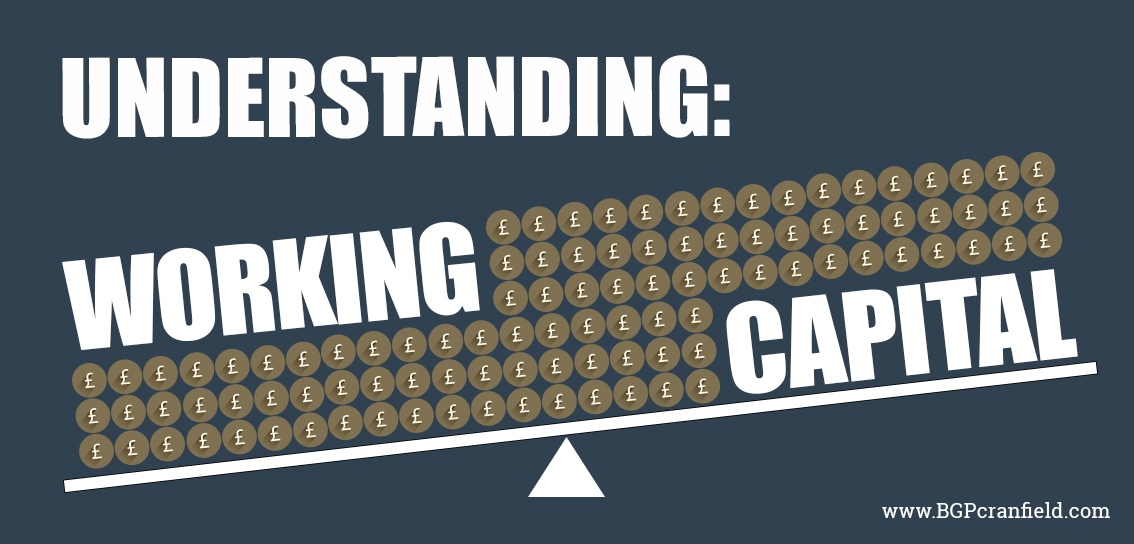
In the last Management Essentials blog, we looked at 5 key sales and profit terms, we will now provide explanations for the basic things needed to understand business cash-flow and the business phenomenon commonly known as “working capital”.
Having worked with hundreds of SMEs through Cranfield’s Business Growth Programme (BGP), for over 10 years now, it is more often than not, a lack of know-how with finance that inhibits business owners and hampers or restricts business growth.These blog posts will hopefully provide you with enough knowledge and a real grasp of the key terms that will then prove very useful when looking at your business growth opportunities.
What is Working Capital?
Absorbing the answer to this is crucial to understanding how business actually works. Simply put, working capital is the “life blood” of a business. It is the cash required to fund the day-to-day operations of the business, to ensure stuff gets delivered to customers, staff get paid, suppliers get paid, the taxman and banks get paid and the business is able to afford to stay in business. Always and everywhere, businesses go bust because they run out of cash. Some businesses were never going to be successful (bad products, poor service offering, the wrong markets at the wrong time etc.). However, many more promising businesses, which could have had massive potential to succeed, have gone bust because of a lack of understanding of how to plan and manage their working capital. Luckily, for a lot of the businesses we work with on BGP and Essential Management, we are able to identify and rectify this threat, and hopefully, this blog will provide some help for you and your business also.
|
So, how do you measure working capital? The answer lies in the interplay between three key business metrics which in turn drive a crucial fourth metric:
1. Debtor days (money that people owe you)
This is a VERY important number for a lot of small businesses to manage. It is a measure of how long on average it takes your customers to pay you what they owe you. Typically, many businesses will find that large customers demand 60-day credit terms, which means they could be expected to pay 60 days after receiving their invoice. If you don’t have a “credit controller” (or someone with similar responsibility) to chase customers who are slow to pay, you might easily find the debtor period drifting out to 90 or 100 days. If you are also slow getting your invoices out, you will be adding to the delay and be in a situation where 4 months after supplying goods or services (the provision of which cost you a lot of money) you still haven’t been paid!
Some businesses notably in the retail sector are fortunate that they get paid straight away (often selling stock that they haven’t yet paid for) which gives them a massive cash-flow advantage.
The easy way to calculate debtor days is to take the level of debtors, divide it by annual sales and multiply by 365 and this tells you how many days of sales remain unpaid at the present time. So if you have £150k owed to you by customers and your annual turnover is £900k you have around 61 days of debtors outstanding.
2. Stock days (money invested in what you sell)
If your business needs to keep shelves of goods for sale, or tanks of fuel or warehouses of spare parts etc. then efficient management of stock levels is essential to maintaining a healthy cash-flow. No-one wants to lose sales because they have run out of stock too quickly but bulk-buying and keeping way too much stock can be a huge drain on business cash-flow and mean you are keeping stock that won’t be sold for months!
Also, stock need not be physical, because work in progress (WIP) also counts as stock and many businesses e.g. consultancies working on projects, lawyers working on long cases, accountants preparing financial statements etc. will all have invested significant sums in creating some “stock” which they haven’t yet billed for.
To calculate how many days of sales are tied up funding stock & WIP take the total at any point, divided by annual sales and multiply by 365. Hence if you are a small engineering firm with £120k worth of raw materials and/or goods ready for sale plus £80k worth of stuff in the process of being made (WIP) and you turn over £1800k per annum you’d have about 41 days of sales tied up in the factory.
3. Creditor days (the free period before you have to pay for stuff you’ve bought)
One of the great things about running a business is that you can often get stuff delivered to you and sell it before you have to pay for it. This is why big retailers like Tesco are able to expand so fast - because they don’t have to spend any money on working capital. However, for many businesses the amount they can get in “free” credit is nowhere near enough to offset the amount of money they have had to sink into funding their debtors and their stock, and all they can do is make sure that they are getting as much free credit as is reasonable in their industry (i.e. not getting to the point where suppliers refuse to deal with them).
To look at how many days of sales are funded free by creditors (people you owe money to) take the figure for trade-related creditors divide by annual sales and multiply by 365. So if you run a pub and you owe £60k to a variety of suppliers and your annual turnover is £750k, we can say that you are getting around 29 days free credit.
4. The working capital to sales ratio (how much it costs to fund £1 of new sales)
This is the most vital ratio to track, for effective management and planning of business cash-flow. “working capital” is the NET amount tied up in Stock & Debtors (which have cost you cash) less the amount you owe to creditors (which is free until you pay it). The relationship between this amount and your annual sales tends to be quite stable in well-managed non-seasonal businesses (although it does vary a lot for seasonal businesses).
Let’s suppose you run a printing company with annual sales of £5.8m. You have £450k of debtors, £300k of stock & WIP and you owe suppliers £170k – this means you have 450+300-170 = £580k of working capital. Your working capital to sales ratio is, therefore, £580k/£5.8m which is 10%.This is important because it limits how fast you can grow – for every extra £100 of new sales you’d need to find £10 to finance extra working capital. If your Net Margin was below 10% this would mean that all of your extra profit and more would be absorbed by working capital and therefore the new £100 of sales would have a negative effect on cash-flow for the first year before contributing thereafter.
Working Capital isn’t particularly complicated, as long as you take into account the above 4 metrics and remember these 5 sums:
- Debtor days = The level of debtors (how much you are owed) / annual sales (turnover) x 365 (days of the year)
- Stock days = Your total stock value (including WIP) / annual sales (turnover) x 365 (days of the year)
- Creditor days = The figure for trade-related creditors (money you owe to suppliers) / annual sales (turnover) x 365 (days of the year)
- Working capital = The level of debtors (how much you are owed) + your total stock value (including WIP) – the figure for trade-related creditors (money you owe to suppliers)
- Working capital to sales ratio = Working capital / annual sales (turnover)
Armed with these 5 sums you will, at the least, be able to see if your growth plans are potentially self-funding or more likely, how much you might need to borrow or invest.
Thank you to Andy Haworth for providing this blog post.
Andy is the Programme Director of the Essential Management and Finance Fundamentals programmes here at Cranfield University. He is also a Lecturer and Counsellor on the Business Growth Programme (BGP).



